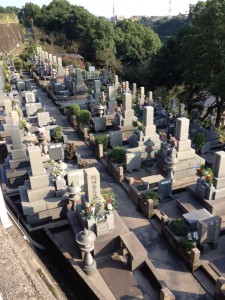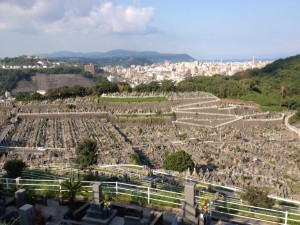The Cemetery Posted by Marcel on Sep 28, 2012 in Uncategorized
Unlike カナダ (Canada) and many western countries, the 春 (はる/spring) equinox and 秋 (あき/fall) equinox are national holidays in 日本 (にっぽん/Japan). Many people use this time to go to the 墓地 (ぼち/cemetery) to pray for their deceased family members and relatives. While the 夏 (なつ/summer) Obon holiday is perhaps the most popular time to go to the 墓地 (ぼち), you will still see a fair amount of people around 9月22日 (くがつ にじゅうに にち /September 22nd) and around 3月20日 (さんがつ はつか/March 20th).
Japanese 墓地 (ぼち) are a lot different than the christian ones I’m used to in カナダ. For example, each family has a site with a large 墓 (はか/grave or tomb) that is used for the whole family, instead of a 墓 (はか/grave) and 墓石 (はかいし/gravestone) for each person. The 墓 (はか) and 墓石 (はかいし) usually faces due 東 (ひがし/east), to face the rising 太陽 (たいよう/sun). For that reason, 墓地 (ぼち) are not often on the 西 (にし/west) side of hills, but when they are the 墓 (はか) could face into the hill! It can be quite surprising to see hundreds of 墓 (はか) all facing the exact same direction.
When someone passes away, their name is usually added to a secondary stone tablet which contains the names/ages/dates of all the other family members who died in the past. If a 墓 has been used for a long time, there could easily be several generations of 名前 (なまえ/names) listed at one 墓. Unlike christian 墓, the Japanese do not bury the whole body. They will place any 骨 (ほね/bones) that remained after 火葬 (かそう/cremation) in a small chamber at the base of the main stone. Finally, 花 (はな/flowers) are placed on either side of the main stone, 水 (みず/water) is left as a gift to the deceased, and 線香 (せんこう/incense) is burned in front whenever people visit and pray.

Build vocabulary, practice pronunciation, and more with Transparent Language Online. Available anytime, anywhere, on any device.






Comments:
Tim Upham:
Around 200 B.C., Japanese leaders were buried in tombs. Then around 300 B.C., they were buried in earthen mounds or kofan, which means “ancient grave.” A stone coffin was placed in the chamber, with swords and bronze mirrors, on the inside and the outside. Himiko, a Shaman queen was buried in one. Are today’s mikos descendants of the great queen. Were the bronze mirrors used to see the reflection of Amaterasu?